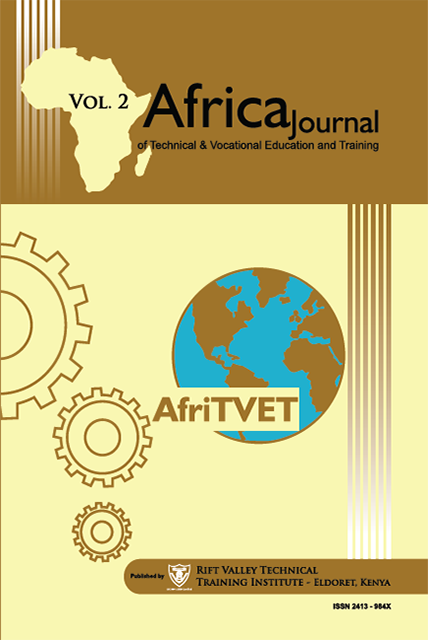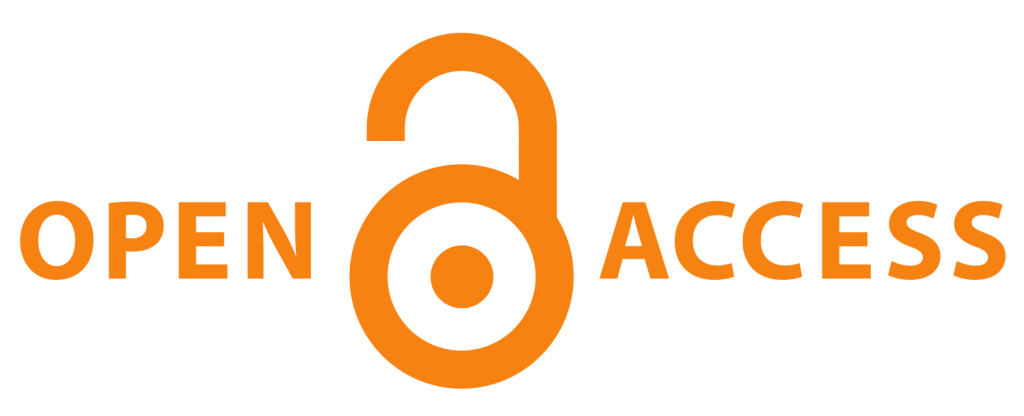Factors Influencing The Adoption Of Flexible Teaching Approaches In Technical Training Institutions In Kenya
Keywords:
Flexible approach, Institutional factors
Abstract
The goal of training in technical training institutions is to produce highly skilled graduates with competencies to handle various challenges in technology oriented fields. The continuing need to improve the quality of education in Technical Vocational Education and Training (TVET) is ever present. Therefore, effective teaching at these institutions is important to enhance quality of its graduates. This paper highlights the factors influencing the adoption of flexible approaches to teaching in technical training institutions in Kenya. Two specific objectives are addressed here are to establish how the syllabus content influences the adoption of flexible approaches to teaching and evaluate how institutional factors influence the adoption flexible approaches to teaching. The study was guided by a conceptual framework developed by the author. This study was conducted through descriptive research design. Data were collected from seven technical training colleges in Western Kenya. The method of data collection was through open and closed-ended structured questionnaires, and interview schedules. Collected data were coded in SPSS 17.0, and analysed using descriptive statistics. The study established that institutional managers had no authority to develop their own courses that are tailor-made to suit specific needs in the market. The teaching resources that influence the adoption of flexible learning and teaching were also found to be unavailable in classrooms. Most institutions however had put in place strategic objectives to improve the quality of learning and teaching. Outputs from this study are expected to enhance the adoption of flexible learning in technical training institutions. In light of the findings of the study, it was recommended that the government of Kenya should establish a clear policy aimed at greater adaptability to flexibility. Institutions need to be granted authority to develop and reorganise syllabi for provision of industry-specific solutions while being regulated to meet international standards.Article Views and Downloands Counter
Download data is not yet available.
References
Arfield, J., Wade, W., Hodgkinson, K., Smith, A., Beaverstock, J., Brown, E.,… Wright, I. (2013). Flexible learning in highier education: Teaching and learning in highier education. London: Routledge.
Cochran-Smith, M. (2004). Taking stock in 2004: Teacher education indangerous times. Journal of Teacher Education, 55(1), 3-7.
Collis, B & Moonen, J. (2001). Flexible learning in a digital world - experiences and expectations. London: Kogan Page, 232, ISBN 0-0794-3371-X.
Commonwealth of Learning. (2012, Feb). Connections, Learning for Development, 2012. Vol 17, (No 1.). Canada: Commonwealth of Learning.
Ellington, H. (1997). Flexible learning - your flexible friend . In C. Bell, M. Bowden, & A. T. (Eds.). Implementing flexible learning: Aspects of educational and training technology XX1X. London: Kogan Page.
Harper, B., Hedberg, J., Bennett, S., & Lockyer, L. (2000). Review of research. The on-line experience: The state of Australian on-line education and practices. South Australia: Australian National Training Authority.
Harry, K. (2002). Higher education through open and distance learning. London: Routledge.
Horton, W. (2000). Designing Web-based training. John Wiley & Sons Publisher, 1st edition.
Hudson, R., Maslin, S., & Oates, L. (2013). Flexible learning in action: Case studies in higher education. New York: Routledge.
International Labour Organization. (2003). Training for work in the informal sector: Evidence from Kenya, Tanzania and Uganda. Geneva: ILO.
Khan, B. H. (2007). Flexible learning in an information society. London: Idea group.
King, B. (2001). Managing the changing nature of distance and open learning at institutional level. Open Learning, 16 (1), 47-60.
Kothari, C. (2004). Research methodology: Methods and techniques. Daryaganj, New Delhi: New Age International.
Ministry of Education. (2009). Education statistics department report. Nairobi: Ministry of Education.
Ministry of Education. (2012). A policy framework for education. Nairobi: Government printer.
MoEST, & KIE. (2010). TVET curriculum development framework, final draft.
Nairobi, Kenya: Government Printers.
Moore, M. G. (2013). Handbook of distance education (3rd ed.). London: Routledge. Reif, R. L. (2013, September 26). Education. Retrieved 2014, from Time: http://
nation.time.com/2013/09/26/
Republic of Kenya. (2003). Report of the task force on implementation of free primary education. Nairobi: Jomo Kenyatta Foundation.
Republic of Kenya. (2005). Sessional paper No 1 of 2005 on policy framework on education, training and research. Nairobi: Government printer.
Republic of Kenya. (2007). Kenya Vision 2030. Nairobi: Goverment printer.
Shurville, S., O’Grady, T., & Mayall, P. (2008). Educational and institutional flexibility of Australian educational software. Campus wide information systems, 25(2), 74-84.
Simiyu, J. W. (2007). Introducing e-learning as a strategy to increase enrolment in TVET. 1st African UNESCO-UNEVOC Summit on access and inclusion for TVET in Africa through new ICT-based solutions. Safari Park Hotel, Nairobi: UNESCO. Retrieved from www.unevoc.unesco.org: www.onevoc.unesco. org/publications
Stredwick, J., & Ellis, S. (2005). Flexible working. New York: CIPD Publishing.
Terry, D. (2000). Changing university teaching: Reflections on creating educational technologies, open and distance learning series. Hove, United Kingdom:Psychology Press.
Tucker, C. R. (2013, March). The basics of blended instruction. Technology-Rich Learning, 70(6), 57-60.
Cochran-Smith, M. (2004). Taking stock in 2004: Teacher education indangerous times. Journal of Teacher Education, 55(1), 3-7.
Collis, B & Moonen, J. (2001). Flexible learning in a digital world - experiences and expectations. London: Kogan Page, 232, ISBN 0-0794-3371-X.
Commonwealth of Learning. (2012, Feb). Connections, Learning for Development, 2012. Vol 17, (No 1.). Canada: Commonwealth of Learning.
Ellington, H. (1997). Flexible learning - your flexible friend . In C. Bell, M. Bowden, & A. T. (Eds.). Implementing flexible learning: Aspects of educational and training technology XX1X. London: Kogan Page.
Harper, B., Hedberg, J., Bennett, S., & Lockyer, L. (2000). Review of research. The on-line experience: The state of Australian on-line education and practices. South Australia: Australian National Training Authority.
Harry, K. (2002). Higher education through open and distance learning. London: Routledge.
Horton, W. (2000). Designing Web-based training. John Wiley & Sons Publisher, 1st edition.
Hudson, R., Maslin, S., & Oates, L. (2013). Flexible learning in action: Case studies in higher education. New York: Routledge.
International Labour Organization. (2003). Training for work in the informal sector: Evidence from Kenya, Tanzania and Uganda. Geneva: ILO.
Khan, B. H. (2007). Flexible learning in an information society. London: Idea group.
King, B. (2001). Managing the changing nature of distance and open learning at institutional level. Open Learning, 16 (1), 47-60.
Kothari, C. (2004). Research methodology: Methods and techniques. Daryaganj, New Delhi: New Age International.
Ministry of Education. (2009). Education statistics department report. Nairobi: Ministry of Education.
Ministry of Education. (2012). A policy framework for education. Nairobi: Government printer.
MoEST, & KIE. (2010). TVET curriculum development framework, final draft.
Nairobi, Kenya: Government Printers.
Moore, M. G. (2013). Handbook of distance education (3rd ed.). London: Routledge. Reif, R. L. (2013, September 26). Education. Retrieved 2014, from Time: http://
nation.time.com/2013/09/26/
Republic of Kenya. (2003). Report of the task force on implementation of free primary education. Nairobi: Jomo Kenyatta Foundation.
Republic of Kenya. (2005). Sessional paper No 1 of 2005 on policy framework on education, training and research. Nairobi: Government printer.
Republic of Kenya. (2007). Kenya Vision 2030. Nairobi: Goverment printer.
Shurville, S., O’Grady, T., & Mayall, P. (2008). Educational and institutional flexibility of Australian educational software. Campus wide information systems, 25(2), 74-84.
Simiyu, J. W. (2007). Introducing e-learning as a strategy to increase enrolment in TVET. 1st African UNESCO-UNEVOC Summit on access and inclusion for TVET in Africa through new ICT-based solutions. Safari Park Hotel, Nairobi: UNESCO. Retrieved from www.unevoc.unesco.org: www.onevoc.unesco. org/publications
Stredwick, J., & Ellis, S. (2005). Flexible working. New York: CIPD Publishing.
Terry, D. (2000). Changing university teaching: Reflections on creating educational technologies, open and distance learning series. Hove, United Kingdom:Psychology Press.
Tucker, C. R. (2013, March). The basics of blended instruction. Technology-Rich Learning, 70(6), 57-60.
Published
2017-10-01
How to Cite
Tiony, A., Kitainge, K., & Ferej, A. (2017). Factors Influencing The Adoption Of Flexible Teaching Approaches In Technical Training Institutions In Kenya. Africa Journal of Technical and Vocational Education and Training, 2(1), 122-131. Retrieved from https://afritvet.org/index.php/Afritvet/article/view/43
Section
ICT AS SUSTAINABILITY ENABLERS
Copyright Notice
Copyright of published articles is held by AfriTVET. No limitation will be placed on the personal freedom of authors to copy or to use in subsequent work, material contained in their papers. Please contact the Publisher for clarification if you are unsure of the use of copyright material. Apart from fair dealing for the purposes of research and private study, or criticism and or review, this publication may only be reproduced, stored or transmitted, in any form or by any means, with the prior permission in writing of the Publishers.



